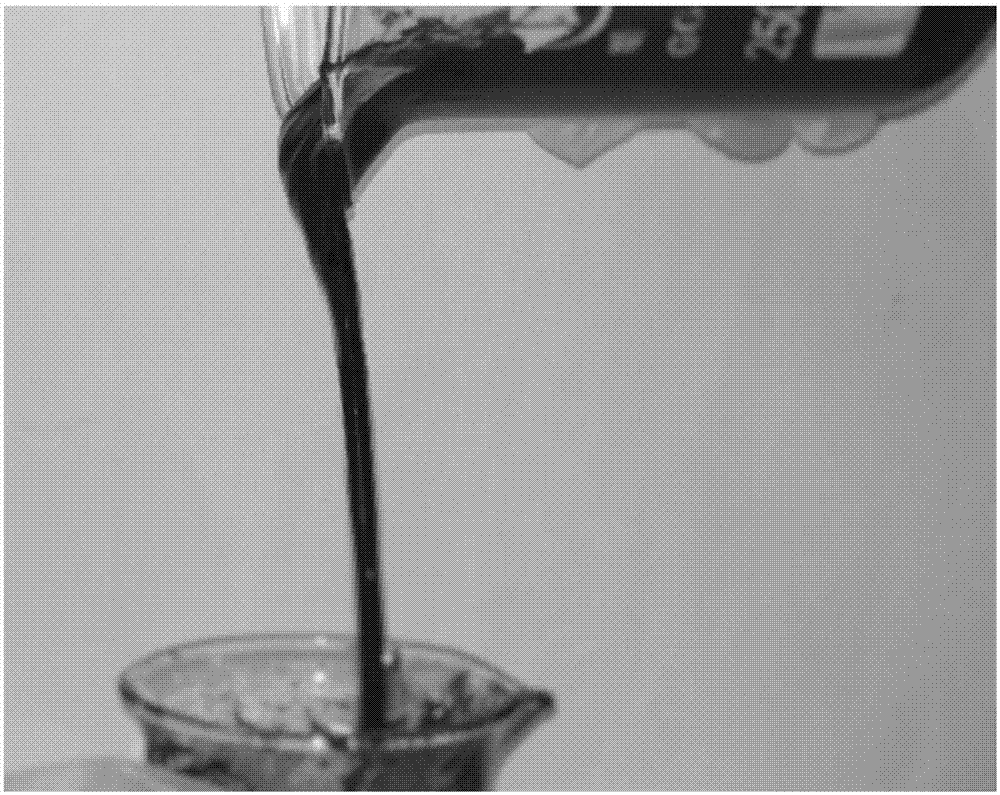Phenolic resin adhesive synthesized through in situ alkali lignin autocatalysis and preparation method of phenolic resin adhesive
A technology of alkali lignin and phenolic resin, applied in the field of phenolic resin adhesive and its preparation, can solve problems such as activity reduction, and achieve the effects of simplifying steps, reducing costs, and improving production efficiency
- Summary
- Abstract
- Description
- Claims
- Application Information
AI Technical Summary
Problems solved by technology
Method used
Image
Examples
Embodiment 1
[0031] (1) Mix 50g of crushed bamboo with 50g of 2.0% dilute sulfuric acid solution with a mass fraction of sulfuric acid, stir and heat at 70°C for 4h, then filter, wash with 6L deionized water until nearly neutral, and dry in an oven Obtain filter residue.
[0032] (2) Take 8 g of the above-mentioned bamboo residues treated with dilute sulfuric acid, add 72 g of 5.0 mol / L KOH to a 100 mL reactor, and react at 110° C. for 3 h. Then carry out suction filtration, and the filtrate is the alkali lignin stock solution.
[0033] (3) Blend 100 mL of the above-mentioned alkali lignin stock solution with 5 g of phenol, heat up to 90° C., and heat and stir for 0.5 h to obtain a phenolized modified alkali lignin solution;
[0034] (4) Add 2.0 g of formaldehyde solution to the above-mentioned phenolized modified alkali lignin solution, and perform in-situ polymerization at 90° C. for 3 hours;
[0035] (5) Add 0.4 g of urea to the above in-situ polymerization solution, react at 70° C. f...
Embodiment 2
[0038] (1) Mix 50 g of crushed rice straw with 250 g of dilute sulfuric acid solution with a sulfuric acid mass fraction of 7.0%, stir and heat at 85°C for 3 hours, then filter, wash with 6L deionized water until nearly neutral, and dry in an oven Obtain filter residue.
[0039](2) Take 8 g of the above-mentioned rice straw treated with dilute sulfuric acid, add 48 g of 6.0 mol / L NaOH to a 100 mL reactor, and react at 70° C. for 6 h. Then carry out suction filtration, and the filtrate is the alkali lignin stock solution.
[0040] (3) Blend 100 mL of the above-mentioned alkali lignin stock solution with 7.5 g of phenol, heat up to 70° C., heat and stir for 4.0 h, and obtain a phenolized modified alkali lignin solution;
[0041] (4) Add 2.4 g of formaldehyde solution to the above-mentioned phenolized modified alkali lignin solution, and perform in-situ polymerization at 80° C. for 0.5 h;
[0042] (5) Add 0.35g of urea to the above in-situ polymerization solution, react at 80°C...
Embodiment 3
[0045] (1) Mix 50 g of crushed rice husk with 400 g of dilute sulfuric acid solution with a sulfuric acid mass fraction of 6.0%, stir and heat at 95° C. for 2 h, then filter, wash with 6 L of deionized water until nearly neutral, and dry in an oven Dry to obtain a filter residue.
[0046] (2) Take 8g of the above-mentioned rice husks treated with dilute sulfuric acid, add 64g of 1.0mol / L Ca(OH) 2 In a 100mL reactor, react at 90°C for 9h. Then carry out suction filtration, and the filtrate is the alkali lignin stock solution.
[0047] (3) Take the above-mentioned 100mL alkali lignin stock solution and blend it with 6.0g phenol, raise the temperature to 80°C, heat and stir for 1.5h, and obtain a phenolized modified alkali lignin solution;
[0048] (4) Add 1.5 g of formaldehyde solution to the above-mentioned phenolized modified alkali lignin solution, and perform in-situ polymerization at 85° C. for 0.5 h;
[0049] (5) Add 0.3 g of urea to the above in-situ polymerization sol...
PUM
| Property | Measurement | Unit |
|---|---|---|
| Bonding strength | aaaaa | aaaaa |
| Bonding strength | aaaaa | aaaaa |
| Bonding strength | aaaaa | aaaaa |
Abstract
Description
Claims
Application Information
 Login to View More
Login to View More - R&D
- Intellectual Property
- Life Sciences
- Materials
- Tech Scout
- Unparalleled Data Quality
- Higher Quality Content
- 60% Fewer Hallucinations
Browse by: Latest US Patents, China's latest patents, Technical Efficacy Thesaurus, Application Domain, Technology Topic, Popular Technical Reports.
© 2025 PatSnap. All rights reserved.Legal|Privacy policy|Modern Slavery Act Transparency Statement|Sitemap|About US| Contact US: help@patsnap.com

